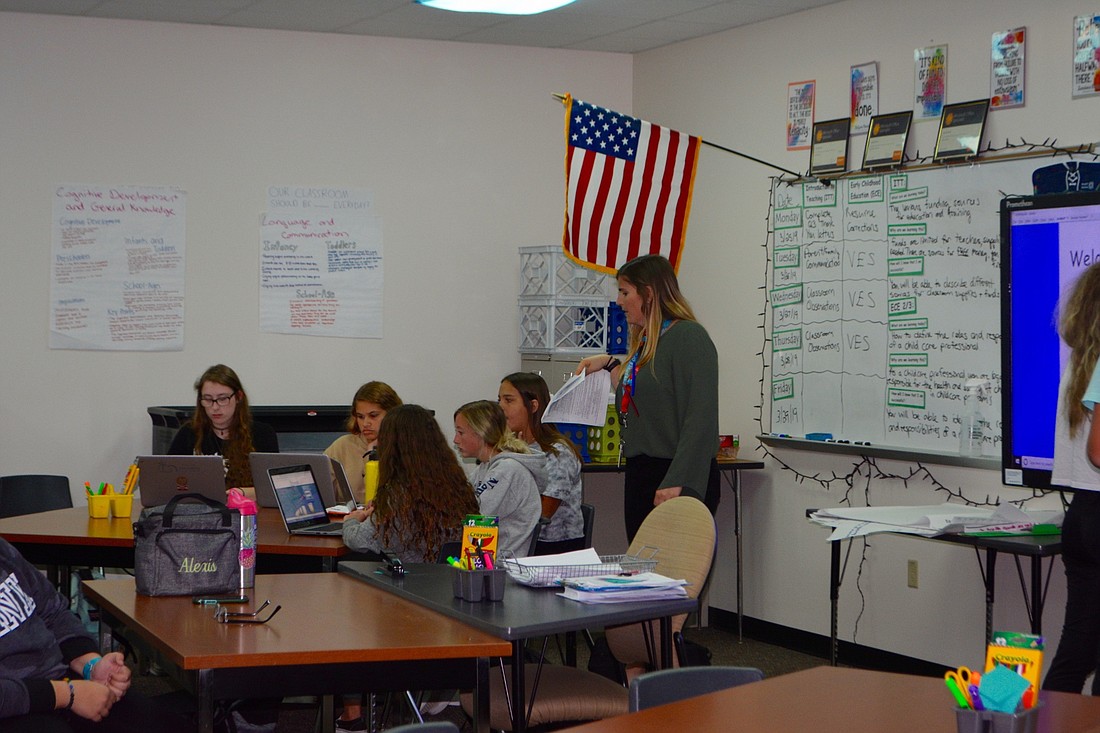- January 14, 2025
-
-
Loading

Loading

On the first Monday morning after Sarasota County Schools’ spring break, teacher Mary Dembinski convened with a group of her students during her morning advisory period.
As she helped them shoot a commercial for the morning news at Venice High, they giggled and pretended to drop their belongings, posing next to each other and calling for their peers to donate to a supply drive for a neighboring elementary school.
But Dembinski and her students in the Florida’s Future Educators of America Club don’t meet weekly just to plan events and goof off in front of a camera. Instead, they meet to study skills needed as a teacher, such as behavior, time management and classroom management. They even have a chance to test their skills when they host day camps for teachers’ children during professional days when school is out but educators are working.
It is Dembinski’s hope that the club will help to provide a direct funnel of new teachers for Sarasota County.
In recent years, teacher preparation programs nationwide have seen a steady decline in enrollment, and with it the pool of available teachers from which administrators could fill open teaching positions.
And Sarasota County, one of the highest paying school districts in the Florida, is not immune to this nationwide teacher shortage.
According to a study conducted by the Charles & Margery Barancik Foundation, which runs a specific initiative aimed at elevating the teaching profession, the student population in Sarasota County is projected to increase over the next five years from about 43,000 students to nearly 46,500. Another 151 teachers will be needed over five years, the foundation says, to maintain the current student-teacher ratio of 17-to-1.
“The problem with that is that the state of Florida does not produce enough teachers on a yearly basis to fill the need of all of the districts in Florida,” said Roy Sprinkle, executive director of Sarasota County Schools Human Resources. “There has been a nationwide shortage of teachers since I walked into this job 13 years ago. … The problem is always in critical shortage areas, which, for us, are math, science and exceptional student education.”
By mid-March, a total of seven open instructional positions were listed on Sarasota County Schools’s job posting website. And, according to Sarasota County Schools spokeswoman Kelsey Whealy, there were 57 long-term substitutes in Sarasota County classrooms helping to fill in the gaps at that time.
In effect, Sarasota County Schools were short by 64 total full-time instructors.
Neighboring Manatee County had 19 open instructional openings and 40 long-term substitutes by mid-March, or a total of 59 open instructional positions — fewer than Sarasota County, though Sarasota County pays its teachers approximately $7,000 more per year than Manatee County on average.
Comparisons aside, both the Barancik Foundation and the Sarasota County School Board have been asking one major question: What’s behind the shortage?
For one, better pay doesn’t always equate to a better standard of living.
In conducting a countywide survey of local teachers, the Barancik Foundation reported that affordable housing is one of the most consistent complaints of incoming teachers.
“When it comes as a bonus, this is not something that the teachers can bank on,” School Board member Shirley Brown said during a Feb. 19 School Board workshop. “You can’t go and get a loan or apply for an apartment with a bonus that may disappear the next year.”
“Cost of living is high here,” Sprinkle echoed of the housing concern. “North Port is better, though, as are neighboring counties. But then, there’s also the issue of the supply of housing.”
Job dissatisfaction can also dissuade Florida’s “best and brightest” educators from sticking around, said Sarasota Schools Program Specialist Cyd Quinn, who helped present the Barancik Foundation’s survey to the School Board.
“I’m in my sixth year of teaching and I have friends who have already left because of the problems,” Dembinski said. “They’re asking more of us every year and it is stressful . . . The turnover rate is so high, and it’s disheartening.”

Meanwhile, Sprinkle says that Sarasota County specifically struggles more with recruitment than retention, for it largely lacks the time, money and personnel required to effectively recruit.
“When I walked into this department 13 years ago, we had a budget of over $250,000 for recruitment and we had a retention and recruitment specialist,” he said. “As of this year, our recruitment budget was down to zero and we no longer have the position of recruitment and retention specialist.”
To combat this, the school district is looking to modernize its hiring strategies by being more proactive and streamlined.
For example, hiring fairs, teaching residencies and increased relationships with in-state colleges are among recommendations provided by the Barancik Foundation to the School Board for recruitment.
The foundation also funds Dembinski’s FFEA Club, as well as similar clubs at Booker and North Port high schools, in an attempt to generate teachers from within the district.
And based on the dreams of some of Dembinski’s students, it just might work.
“I’ve been here all my life, and my mother is a teacher in North Port,” aspiring teacher Hailey Hutson said of her desire to teach in Sarasota County. “I love the Sarasota area, and I definitely would not mind being here for the rest of my life.”
“I want to be a teacher because I know good teachers can have a big influence on students, and I want to be that big influence,” FFEA member Gavin Drobisch said. “I definitely [want to come back]. I want to live here and, being a teacher, even at Venice High where I went to school? That would be very cool.”